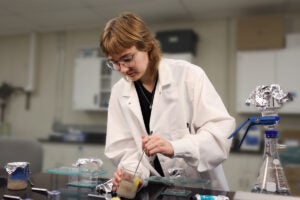Six months after an earthquake devastated Haiti, Karen Pavelka, conservator and lecturer in the School of Information, spent 10 days in Port-au-Prince helping document and conserve the country’s archives. Pavelka sat down for an interview with KUT’s Erika Aguilar prior to her departure to Haiti. Listen to the interview in the audio portrait below.
Pavelka also sat down with Amy Crossette, director of public affairs at the School of Information, upon her return to discuss her experiences as a paper conservator in Haiti.
You visited Haiti on behalf of the American Institute for the Conservation of Historic and Artistic Works (AIC). What is the purpose of the institute and why are the archives in Haiti of interest?
I’m a paper conservator and I serve on the board of directors for AIC. The archives of any country are going to be of historical interest to the people of that country. Right now the importance of Haiti is based on its needs. The earthquake was catastrophic to the archives of that country, and it has threatened to wipe out a good bit of their cultural heritage.
Where in Haiti did you do your research?
I was working at the Haiti Cultural Recovery Project in Port-au-Prince. The project, initiated by the Smithsonian Institute, is located in a building that had previously been inhabited by the United Nations. The building was relatively undamaged by the earthquake. They did not have the resources to create a full-fledged conservation lab. This is a very basic lab that allows for objects to be brought in for stabilization, however, not for cosmetic treatments.
Who was working in the lab with you?
The individuals working in the lab were from a variety of organizations, including AIC’s Cultural Emergency Response Team (CERT), a program started years ago to train people across the U.S. to be able to respond to disaster situations such as this. Sixty-one people went through command system training and learned to develop communications strategies used in disaster response. Many of these individuals were some of the first to arrive and help organize the effort.
When did conservation volunteers first begin to arrive in Haiti?
We began to organize immediately after the earthquake. However, in the immediate aftermath of the earthquake first responders took precedence — human life, medical, safety, food and water. We weren’t able to get into Haiti until May to set up the center. Although our mission is an important one, we had no intention of arriving too early and becoming part of the problem. Since then, there has been a constant stream of volunteer conservators arriving and departing from Haiti.
What condition did you find most of the materials in?
Individuals are bringing items to the center for treatment that have had significant water damage and puncture damage that obviously came from the earthquake. However, we also saw things that were brittle and suffering from what’s called “inherent vice.” Unfortunately, many of the buildings in Haiti have never been air-conditioned and items deteriorate very quickly in the hot, humid climate.
Do you recall any specific pieces you worked on?
I worked on a bound copy of “J’ai un Rêve” — Martin Luther King’s “I Have A Dream” speech. It was a 1987 imprint of the book from the American Embassy to the Haitian National Library. It was not rare or valuable in a monetary sense; however, it is of great historic value.
Is your involvement expected to continue?
I don’t expect to return to Haiti. All of us are working on a volunteer basis, and it’s not easy to make such a time commitment, especially when you’re married. I will continue to work as a consultant for AIC. I learned a lot in the 10 days I was there, and I can help prepare other volunteers for the experience. My colleague, Pat Galloway, is investigating ways to coordinate Haitian resources and materials in other countries in order to build a virtual library for Haiti.
Overall, how would you describe your experience?
The devastation I saw was immense. It’s a very dangerous place for visitors since people are so desperate. We weren’t allowed to go anywhere without an armed guard. We were confined to our hotel for a good amount of time, and our cell phones didn’t work within the country so we could not call home. It made me feel, at times, lonely and isolated. However, the people of Haiti were very warm and welcoming. Even after all they’ve been through, they were extremely gracious and kind. Most are living in tents, amidst the rubble, breathing in carcinogens from the debris and constant burning of rubber. What they’ve endured — and are enduring — is heartbreaking.



